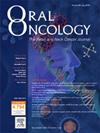Optimization of methylation capture sequencing workflow in formalin fixed tissue from oral squamous cell carcinoma patients
IF 3.9
2区 医学
Q1 DENTISTRY, ORAL SURGERY & MEDICINE
引用次数: 0
Abstract
Background
Oral squamous cell carcinoma (OSCC) is typically diagnosed at advanced stages, resulting in poor survival rates. Epigenetic alterations, especially DNA methylation, are important early and key contributors to OSCC pathogenesis, but comprehensive epigenetic analysis has traditionally been confounded by cancer tissue availability, with fresh-frozen tissues being the gold standard but difficult to obtain.
Methods
This study established and optimized a new workflow for the use of methylation capture sequencing (MC-seq) to analyze DNA methylation profiles in formalin-fixed paraffin-embedded (FFPE) tissues. Twelve OSCC patients were randomly selected from a prospective, multi-institutional study. Paired fresh-frozen and FFPE tissues were collected and processed for DNA extraction and MC-seq. Data were pre-processed using Bismark and methylKit pipelines. Methylation concordance between FFPE and fresh-frozen samples was assessed by comparing β-value correlation.
Results
DNA from FFPE and fresh-frozen OSCC samples showed minimal differences in fragmentation, with FFPE achieving high mapping efficiency (average 71.6%) and retaining an average of about 5 million CpG sites at 10× depth. The distributions of CpG in the methylome region, including promoter, exonic, intronic, and intergenic regions, showed similar patterns between sample types. Additionally, the methylation levels of all matched CpG sites in our 12-gene prognostic panel showed a strong correlation (r ≥ 0.97) between FFPE and fresh-frozen samples.
Conclusion
Our findings indicate that FFPE samples are reliable for methylation capture sequencing, offering a new, scalable and reliable alternative to fresh-frozen samples for large-scale OSCC research.
口腔鳞状细胞癌福尔马林固定组织甲基化捕获测序流程优化
背景:口腔鳞状细胞癌(OSCC)通常在晚期诊断出来,导致生存率低。表观遗传改变,特别是DNA甲基化,是OSCC发病的重要早期和关键因素,但全面的表观遗传分析传统上与癌症组织的可用性相混淆,新鲜冷冻组织是金标准,但难以获得。方法建立并优化了甲基化捕获测序(MC-seq)分析福尔马林固定石蜡包埋(FFPE)组织DNA甲基化谱的新工作流程。从一项前瞻性、多机构研究中随机选择12例OSCC患者。收集配对的新鲜冷冻组织和FFPE组织,进行DNA提取和MC-seq处理。使用Bismark和methylKit管道对数据进行预处理。通过比较β值相关性来评估FFPE与新鲜冷冻样品之间的甲基化一致性。结果FFPE和新鲜冷冻OSCC样品的dna片段化差异很小,FFPE具有较高的作图效率(平均71.6%),在10倍深度下平均保留约500万个CpG位点。CpG在甲基组区域的分布,包括启动子、外显子、内含子和基因间区域,在不同样品类型之间表现出相似的模式。此外,在我们的12个基因预后小组中,所有匹配的CpG位点的甲基化水平在FFPE和新鲜冷冻样本之间显示出很强的相关性(r≥0.97)。结论FFPE样品是可靠的甲基化捕获测序,为大规模OSCC研究提供了一种新的、可扩展的、可靠的替代新鲜冷冻样品的方法。
本文章由计算机程序翻译,如有差异,请以英文原文为准。
求助全文
约1分钟内获得全文
求助全文
来源期刊

Oral oncology
医学-牙科与口腔外科
CiteScore
8.70
自引率
10.40%
发文量
505
审稿时长
20 days
期刊介绍:
Oral Oncology is an international interdisciplinary journal which publishes high quality original research, clinical trials and review articles, editorials, and commentaries relating to the etiopathogenesis, epidemiology, prevention, clinical features, diagnosis, treatment and management of patients with neoplasms in the head and neck.
Oral Oncology is of interest to head and neck surgeons, radiation and medical oncologists, maxillo-facial surgeons, oto-rhino-laryngologists, plastic surgeons, pathologists, scientists, oral medical specialists, special care dentists, dental care professionals, general dental practitioners, public health physicians, palliative care physicians, nurses, radiologists, radiographers, dieticians, occupational therapists, speech and language therapists, nutritionists, clinical and health psychologists and counselors, professionals in end of life care, as well as others interested in these fields.
 求助内容:
求助内容: 应助结果提醒方式:
应助结果提醒方式:


